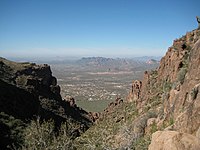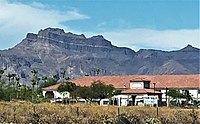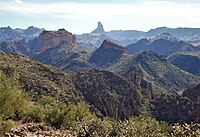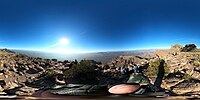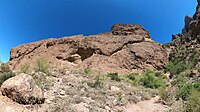Superstition Mountains
History and description
The mountains were once known in Spanish as Sierra de la Espuma ("Foam Mountain").
The range has a maximum elevation of 6,266 ft (1,910 m) and prominence of 1,706 ft (520 m) at Mound Mountain in the far eastern section of the range.
The mountains are in the federally designated Superstition Wilderness Area, and include a variety of natural features in addition to its namesake mountain. Weavers Needle, a prominent landmark and rock climbing destination set behind and to the east of Superstition Mountain, is a tall eroded volcanic remnant that plays a significant role in the legend of the Lost Dutchman's Gold Mine. Numerous hiking trails cross the mountains from multiple access points, including the Peralta Trailhead, the most popular. Peralta Canyon, on the northeast side of Superstition Mountain, contains a popular trail that leads up to Fremont Saddle, which provides a very picturesque view of Weavers Needle. Miner's Needle is another prominent formation in the wilderness and a popular hiking destination. Lost Dutchman State Park, located on the west side of Superstition Mountain, includes several short hiking and mountain bike trails.
Circlestone includes ancient stone monuments.
As with most of the terrain surrounding the Phoenix metropolitan area, the Superstition Mountains have a desert climate, with high summer temperatures and a handful of perennial sources of water. The elevation in the more remote, eastern portion of the wilderness is higher than the western portion, which lowers temperatures slightly.
Legends
The legend of the Lost Dutchman's Gold Mine centers around the Superstition Mountains. According to the legend, a German immigrant named Jacob Waltz discovered a mother lode of gold in the Superstition Wilderness and revealed its location on his deathbed in Phoenix in 1891 to Julia Thomas, a boarding-house owner who had taken care of him for many years. Several mines have been claimed to be the actual mine that Waltz discovered, but none of those claims have been verified. Waltz was a miner at Vulture Mine, where he likely stole the gold and came up with the secret mine to explain his theft. The legends and lore of the Superstition Mountains can be experienced at the Superstition Mountain Museum on the Apache Trail where artifacts of the Lost Dutchman are on display.
Some Apaches believe that the hole leading down into the lower world, or hell, is located in the Superstition Mountains. Winds blowing from the hole are supposed to be the cause of severe dust storms in the metropolitan region.
Nearby towns and cities
- Apache Junction, Arizona
- Gold Canyon, Arizona
- Mesa, Arizona
- Superior, Arizona
- Tortilla Flat, Arizona
Gallery
-
Miners Needle from Bluff Spring Trail. Note prominent bedding planes in the volcanics. (2010)
-
View from the Flatiron hiking trail (2008)
-
Superstition Mountains From Route 60 at Apache Junction (2021)
-
Mining – of gold, silver and especially copper – has historically been an economically significant activity in the mountains (2014)
-
A view from the Apache Trail (Arizona State Route 88) in 2016
-
Boulder Canyon Trail – Weaver's Needle in distance (2011)
-
Petroglyphs in Superstition Wilderness (2007)
-
panorama, taken from Flatiron, in the Superstition mountains.
-
Ironview Peak (peak 5024), background, left
-
Western Superstition mountains, viewed from Siphon Draw trail.
-
Rock formations, Siphon Draw trail.
-
Rock formation, Siphon Draw trail.
-
view from Superstition Ridgeline Trail
-
Panoramic view from Siphon Draw, basin area. .
-
Panoramic view from Siphon Draw Trail.
-
Panoramic view from Siphon Draw Trail.
See also
References
- ^ "Superstition". NGS Data Sheet. National Geodetic Survey, National Oceanic and Atmospheric Administration, United States Department of Commerce. Retrieved June 8, 2011.
- ^ "Superstition Benchmark, Arizona". Peakbagger.com. Retrieved June 8, 2011.
- ^ "Maps | Data Basin". databasin.org. Retrieved December 28, 2018.
- ^ "Mound Mountain, East Superstition Mountains". peakbagger.com. Retrieved September 2, 2016.
- ^ "East Superstition Mountains". peakbagger.com. Retrieved September 2, 2016.
- ^ "Superstition Mountains Benchmark, Western section". peakbagger.com. Retrieved September 2, 2016.
- ^ Kollenborn, Tom (1990). "Weaver's Needle or Picacho?". Archived from the original on October 30, 2004. Retrieved April 1, 2007.
- ^ Carroll, Doug. "Hiking the Supsertitions". Retrieved April 1, 2007.
- ^ Heim, Dave. "Superstition Mountain Museum".
- ^ Vitaliano, Dorothy. 1973. Legends of the Earth, Bloomington: Indiana University Press, pp. 170–171.
External links
- HikeArizona.com: Numbered Trails Map
- Official Apache Trail website: Superstition Mountains
- Tonto National Forest: Superstition Wilderness Area Forest Service information
- Wilderness.net: Superstition Wilderness Area
- GORP.com: Superstition Wilderness
- Ajpl.org: History of the Superstitions
- JustRoughinIt.com: Superstition Wilderness Average Climate

